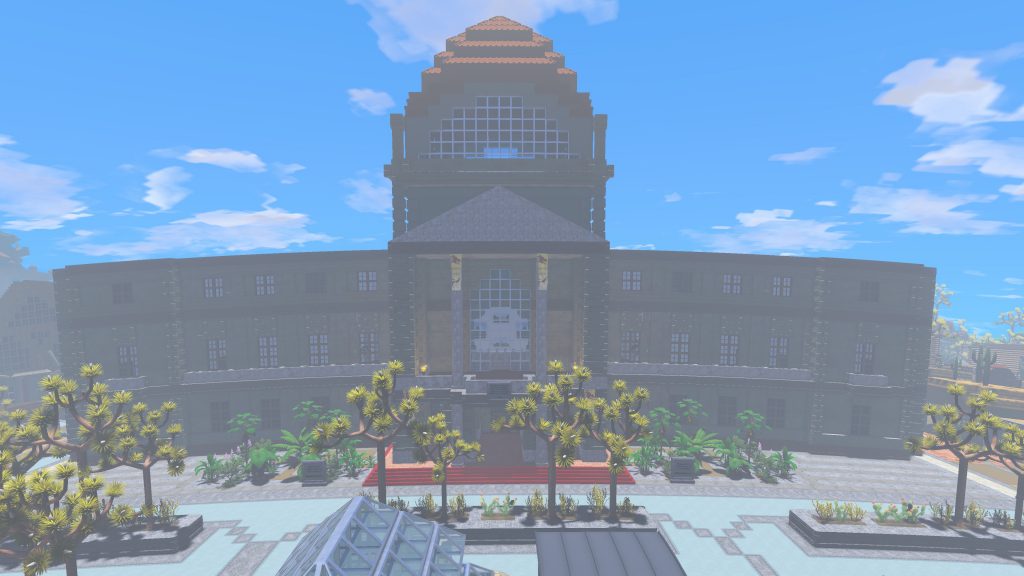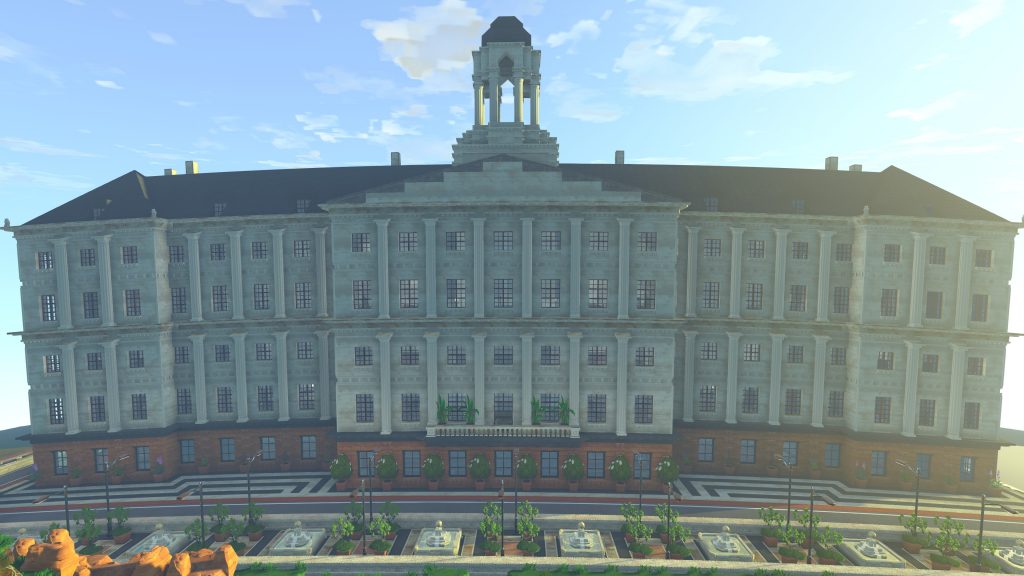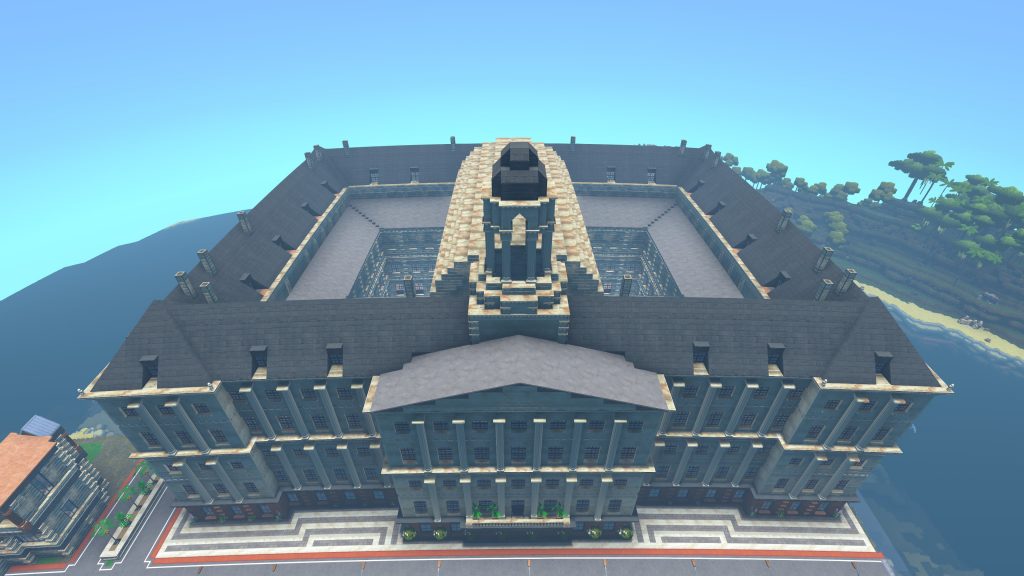Preface

The map as it was at the end of 7.7.2
This server was founded in early November of 2018, after the previous admin unceremoniously pulled the plug on our then-current Beta 7.7.2. We recovered our map about a week later, after which Ferchibald, Kobayashi, Ghost, Coey123 and yours truly switched hosts to become hosted in a dedicated server from Praefator’s home.
During the later part of the map, I invited SatsukiShizuka to become our Bank/Treasurer to manage our fledgling server’s economy.

The town as it was during the Beta 7.8 map cycle

Unity Tower, our first attempt at a City Hall
Early days: Beta 7.7.2 to Beta 7.8.9
Initially, we had but a single currency, which was both to introduce us to the concept of a managed economy (having utilized a more or less shared resource pile before), as well as test the waters as to how the server economy was to take shape.
During 7.8.9 we introduced further refinements to the economy, specifically to create a singular workshop for our Engineering team as well as make it very convenient for miners to sell their mined goods directly to the mason/smith.
Additionally, it was during 7.8.9 where both Lack and Belgareth1987 joined. Lack went on to become Staff as of 8.0, with belgareth1987 following during 8.1

The National ScrewWorks

The predecessor to large-scale building – Transcendence, a mansion serving as city hall during 7.8.9
Beta 8.0: Dawn of Megastructures & Dual Currency
As we moved into the 8.0 map cycle, we started dipping into multiple new innovations, being (to date) one of the few servers successfully implementing a dual-currency setup. Whereas before we taxed people progressively more as their balance grew, with the separation of the previous singular Regal into a predecessor (dubbed ‘Minori’) as well as a mid-game Regal.
As has traditionally been filled by the Regal, the Minori served as the de-facto global currency for the early purchases as well as low value, high volume goods like hewn logs and mortared stone.
As we moved into mid-game however, we created a second Mint for the Regal, which introduced a tax free savings account for the initial tax bracket, and sporting lower tax rates overall.
That is not all however – during 8.0 our first megaproject, dubbed ‘Phoenix Resurgam’ (Latin for “The Phoenix Rises”) was completed, modeled after the Liria Palace in Madrid, Spain. Subsequently, it was heavily featured in followup newsletters about 9.0’s government features, as well as becoming the 15th featured screenshot on Eco’s Steam page.
Lastly, we had the beginnings of a dual settlement setup due to Pater Omnipotens and Djehuty opting to settle on the continent of Rustica while adopting the central city’s currencies and laws.

The 8.0 palace, modeled after the Liria Palace in Madrid, Spain
Beta 8.2: currency refinements & public mine
Innovation-wise, the Beta 8.2 map has had some refinements – all prices were multiplied by 10 so as to be able to balance prices more easily, especially for food as it has traditionally been a weak point.
Additionally, due to the inclusion of the Industrial Elevator, we have been able to refine the public mine to be much better looking. Where before we had to dig ramps all the way down to bedrock (with associated long travel times), this map saw a system of elevators in a lobby, designed for bedrock, granite and (initially) iron ore mining, of which the latter was scrapped in favor of a short ramp down to the ideal iron ore depth in the desert.
While we haven’t been able to succesfully replicate a multi-town system during our Beta 8.2 map cycle, we had anticipated Beta 9.0 to enable multiple towns to spring up across the world much more easily, each with their own set of currency/currencies, laws and governmental system(s).

The map as of Day 40 of the 8.2 map cycle

Imperial Mine Lobby

The Palais du Rhin in all its completed glory
Beta 9.0: Early forays into dual settlements & the folly of Man
While we did end up with two distinct cities of “Dwarves versus Elves”, with the Dwarven capital of Durmgrist and the Elven city of Mingyang, ultimately due to player dropoff over the course of the map both cities worked together as two halves to see the map through to completion.
This additionally meant that the very ambitious central palace of this round, a recreation of Amsterdam’s “Paleis op de Dam” was never completed on the production server. Nonetheless, below are pictures of how it would have looked, had it been completed 🙂

The 9.0 Palace under construction

Paleis op de Dam – Front View

Paleis op the Dam – Overview
Beta 9.2: Apprenticeships & Leapfrogging – because we prosper when all prosper
During Beta 9.2, we introduced the concept of an Apprenticeship Program alongside our Leapfrogging Initiative, where new players are paired with a veteran of the same profession, teaching them the ropes, provide lodging and experience bonuses, as well as provide the opportunity to set off on their own if they so choose.
Something we’re especially proud of, as we firmly believe we prosper when all prosper, regardless of when someone may join a server. In other words, we openly reject the idea that joining a server late is not worth doing. Allow us to show you! 🙂

Our spawn town as it appeared during Beta 9.2. Notice the public housing near the bottom
Beta 9.4: Refining leapfrogging through Public Housing
During Beta 9.4, we expanded upon the Apprenticeship Program by additionally putting in measures to give everyone a fair shot at gaining housing XP, by building out several apartment-sized houses the government rented out to interested parties.

The 9.4.x map, as it ultimately looked
Beta 9.7: Groups vs individual players, and how to prepare for maps differently.
During the Beta 9.7.x days we made another significant change to the way our maps had been setup. While before we liked to pre-plan a lot and prepare our new map based off of the previous map, this time we went with a much more free-form approach, where only the basis for a street network was provided, but otherwise the entirety of the map was up to the players themselves to fill in. By the end of the map, we were featured by SLG, as seen here!
This map additionally sparked a discussion on the role of groups and the power they hold over individual players seeking to compete in the same space. Ultimately it was decided that as of Beta 10.0, groups would be encouraged to find their own island so as to provide more opportunity for individuals to shine, in addition to having restrictions as to how many people could share a single residence, as well as what professions these players would be able to share.
In other words, to make sure two players don’t vertically integrate by becoming their own (only) supplier and/or being able to process the next item in the chain to a finished product, so no farmer/hunter + chef, or smith + engineer. Of course, influence is not going to be global by default anymore, so those who do want to vertically integrate should take heed of which town(s) support such a policy or seek to found a town supporting that.

The 9.7 City Hall with its gardens

9.7 Overview shot

The Meteor Destruction System, based off of the Lighthouse of Alexandria (Pharos)

The latest iteration of Satsuki Tower
Beta 10.0: Multi-settlement play, with a hint of location, location, location
As of Beta 10.0, our default global government ceased to exist. As such, much more emphasis was placed on player agency, the advent of the culture mechanic, and of course, boats!
During our Beta 10.0 we managed to create two smaller Dwarven settlements in a traditional Desert environment with both Forgeways, headed by Praefator on the southern coast and Farforge, headed by Sans Tark more inland. This new settlement saw opportunity to more closely bring the town’s aesthetic together into one cohesive whole.


To their south we had the Elven settlements of Coastburgh, headed by Inistaras on the northern coast of their continent and the more southern situated Free Hong Kong, headed by Satsuki. This was also the first map where we first met up and played with our friends at Eco Pancake!

Beta 10.2: Redefining our city identities
Once 10.0 concluded, we had decided to start incorporating the lessons learned during our 10.0 run, which prepared us better for the challenges to come. During this 23rd cycle town identity came to the forefront, shifting the Dwarves biome of choice from their traditional Desert to a Cold Mountain/Taiga biome with adjacent Desert, strategically placing them in the vicinity of iron, copper and gold ore from one central location.
This change of biome additionally allowed for much more verticality between the residential mountains on the north and its lower located Town Hall, separated by a snaking river. Due to its road design, it sparked a philosophical shift towards splitting home deeds from work deeds and redefining what it means to have a city – to go beyond “a collection of houses around a central Town Hall” towards “a living, breathing city where people live, go to work, hang out with friends and meet new people”.


With this new run, having taken their own lessons from their 10.0 experience, the Elves set out to make their own, better version of their previous town. To that end, they became fully wetlands-based rather than their forest-based start. While initially helped by ample shale supplies, crop potential demanded a shift towards mushrooms, cotton and rice to better position themselves as a food export economy.
Whereas the first Free Hong Kong settlement was an inland city relying on their coastal city to fulfill their needs, the second settlement became a near-coastal settlement with multiple colonies. Supported by significant investments into naval infrastructure and boats, Free Hong Kong 2.0 became capable of solidly supplying the world’s food, material and energy needs.


11.0: Present day – our foray as ambassadors of our way of working
While preparations for our new Round 24 are underway, we were invited by the Eco Pancake community to come play with them and experience their way of playing firsthand. While this necessitated some adjustment on our end, having faced the typical symptoms of response, adjustment and integration to culture shock, we are finding our groove again.
While the 10.x era started showing a rift between both the Dwarves and Elves, we have chosen to band together in a single settlement on this new environment, with promising signs emerging of reconciliation. Naturally, we hope to keep this going as we look to early 2025 when we are once again on “home soil” 🙂
